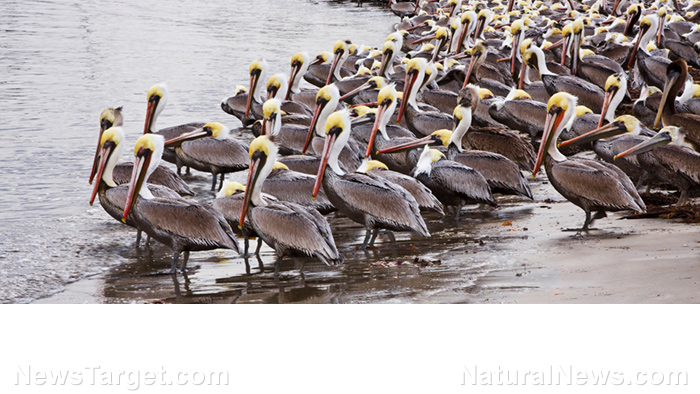Mass bird die-off observed off Florida Coast, sick birds found bleeding from the mouth
05/25/2017 / By Vicki Batts

From the coast of Amelia Island to the southern shores of Ponte Vedra Beach, the outlook for Floridian birds is pretty grim. Pelicans, ospreys, gulls and anhingas are just some of the beautiful feathered creatures that are being affected by a massive die-off, according to a group of marine life researchers.
Hailing from the Florida Sea Grant Extension of Northeast Florida, which is part of the University of Florida/IFAS Extension Program, the team says that the sick birds appear to be “disoriented” and often find themselves far away from their natural habitats — and their feathers are dry, brittle and seem to lack their natural waterproofing. Sometimes, the birds can even be seen bleeding from their beaks — a heartbreaking sight, for sure.
What is causing the plight of these marine birds is not known, but some believe it may be related to what’s described as a “rainbow sheen” sitting atop the waves at the beach of Little Talbot. Many of the sick birds seem to be found around the mouth of the St. Johns River, though sick pelicans have been reported around the lake in the Guana Wildlife Management locale. The Sea Grant Extension team requests that if you see dead birds, do not touch them under any circumstances and make a report to the Florida Fish and Wildlife wild bird mortality database.
The Florida Fish and Wildlife Conservation Commission is sending out veterinarians to collect the deceased birds’ remains for analysis, in the hopes of finding the cause of this disturbing plague of death.
Pelicans have been dying around the Riviera Bay and Coffee Pot Bayou since at least January, according to a report by the Tampa Bay Times. In mid-January, Seaside Seabird Sanctuary’s Eddie Gayton told the Times they were caring for 14 sickened pelicans, and another 22 had passed away. According to Gayton, it appeared that the birds had been poisoned by something, though it was unclear what. Barbara Walker of the Clearwater Audubon Society revealed that other wildlife rehab facilities had been taking in sick birds as well.
She commented, “Nobody has a total. We don’t have a good protocol here (for dealing with sick birds). And these birds are all being treated different at different facilities.”
The plight of seabirds and other marine life in Florida has been a subject of intense debate. While some have posited that the Red Tide algae bloom could be a potential cause of illness, others have suggested that the bird deaths seen in January were linked to the massive Tampa Bay sewage dump that occurred during 2016 storms. Tens of millions of gallons of sewage were dumped into Tampa Bay and Boca Ciega Bay last year after Hurrican Hermine and other storms overwhelmed local treatment facilities. While officials have claimed that the massive sewage dump didn’t harm the environment, reports from last fall show that the waste was indeed suspected of killing birds, even back then.
What is killing the pelicans and other seabirds remains unknown, but is it possible that all these deaths are somehow related? Reports of massive marine life death have been an ongoing issue in Florida. As the Times reports, “So far, the die-off hasn’t approached the level of the one that plagued the Indian River Lagoon on the state’s Atlantic coast between 2012 and 2013. During that time, more than 300 pelicans died, along with dozens of dolphins and more than 150 manatees. Scientists have yet to figure out what killed them — and the manatee die-off began again last year.”
According to the Times, Gayton believes the sick pelicans gathered in January showed signs of being poisoned by Red Tide algae, but whether or not that is the case for the latest group of dead seabirds remains to be seen. [RELATED: Read more stories about the latest environmental concerns at Environ.news]
Sources:
Tagged Under: bird deaths, Die Off, Florida, marine life
RECENT NEWS & ARTICLES
COPYRIGHT © 2017 ENVIRON NEWS




















